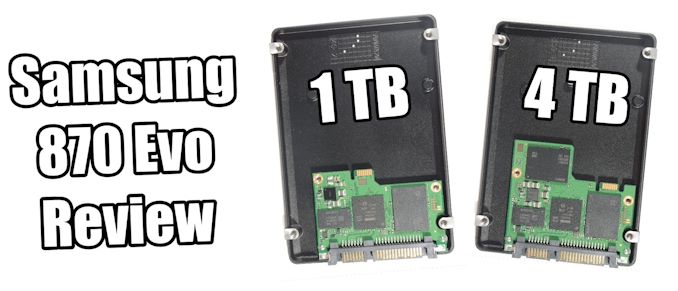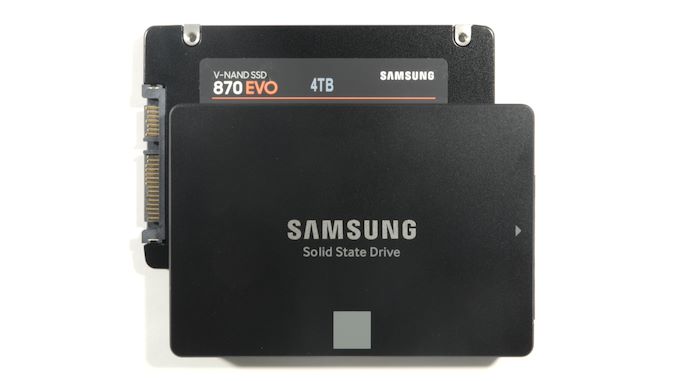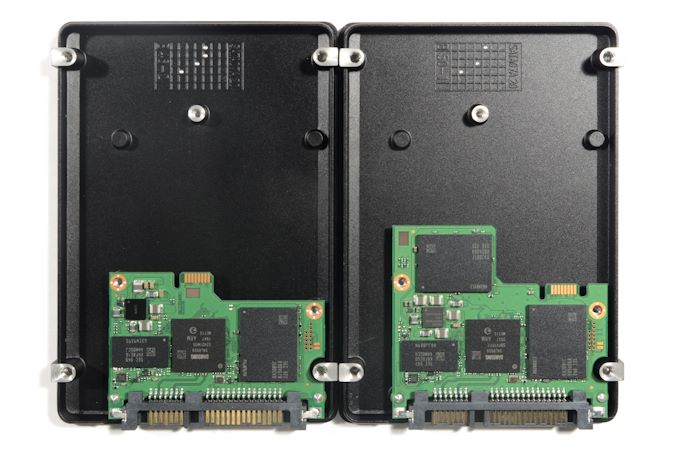The Samsung 870 EVO (1TB & 4TB) Review: Does the World Need Premium SATA SSDs?
by Billy Tallis on February 17, 2021 8:00 AM EST
Samsung has dominated the SSD market for a very long time, and every new consumer SSD model the company introduces is noteworthy. The latest product to reach the shelves is the new range of 870 EVO SSDs, building on a decade-long legacy of SATA SSDs. We have tested the 1 TB and 4 TB models from this new product family.
Pushing for SATA
Samsung is one of the few companies still putting significant effort into SATA SSDs and releasing new consumer SATA models. As PC OEMs have overwhelmingly switched to using NVMe SSDs in new systems, even on the smaller capacities, the client/consumer SATA SSD market now exists almost entirely for the sake of DIY system builders and aftermarket upgrades on older systems. Most major consumer SSD brands have either stopped updating their SATA models, or decided to quietly update components without the fanfare of a new model release. Then there are companies creating odd-ball models, such as a 15.36 TB design. Either way, we don't get many new consumer SATA SSDs in for review these days.
(It is worth noting that the enterprise SATA SSD market has seen somewhat more in the way of visible activity, because the longer product lifetimes in that market and the higher profit margins give SATA SSDs more of a long tail of commercial relevance.)
Despite this market shift, Samsung is still focused on a SATA product line, although even Samsung is showing reduced interest in SATA. It took over six months from the release of the QLC-based 870 QVO for its TLC-based 870 EVO sibling to arrive, and there's still no sign of an MLC-based 870 PRO model (or any other MLC SSDs from Samsung based on anything newer than their 64-layer 3D NAND). Furthermore, the new 870 EVO no longer caters to either mSATA and M.2 SATA form factors, focusing solely on 2.5-inch drives. The mSATA version of the 860 EVO disappeared from the market last year, but the M.2 SATA version is still readily available and has tracked market price trends as much as Samsung's drives ever do. It's a bit of a surprise that they're dropping M.2 SATA this soon given how long Samsung supported mSATA.
Given the roughly three-year cadence Samsung has set for their SATA SSD updates, the 870 generation may also be the last.
| Samsung 870 EVO Specifications | |||||||
| Capacity | 250 GB | 500 GB | 1 TB | 2 TB | 4 TB | ||
| Form Factor | 2.5" 7mm SATA | ||||||
| Controller | Samsung MKX | ||||||
| NAND Flash | Samsung 512Gbit 128L 3D TLC | ||||||
| LPDDR4 DRAM | 512MB | 1 GB | 2 GB | 4 GB | |||
| Sequential Read | 560 MB/s | ||||||
| Sequential Write |
SLC | 530 MB/s | |||||
| TLC | 300 MB/s | 530 MB/s | |||||
| Random Read |
QD32 | 98k IOPS | |||||
| QD1 | 13k IOPS | ||||||
| Random Write |
QD32 | 88k IOPS | |||||
| QD1 | 36k IOPS | ||||||
| Power Draw |
Burst | 3.5 W | 4.0 W | 4.5 W | 5.0 W | ||
| Average | 2.2 W | 2.5 W | |||||
| Idle | 30 mW | 35 mW | |||||
| Warranty | 5 years | ||||||
| Write Endurance | 150 TB 0.3 DWPD |
300 TB 0.3 DWPD |
600 TB 0.3 DWPD |
1200 TB 0.3 DWPD |
2400 TB 0.3 DWPD |
||
| Launch MSRP | $39.99 (16¢/GB) |
$69.99 (14¢/GB) |
$129.99 (13¢/GB) |
$249.99 (12¢/GB) |
$479.99 (12¢/GB) |
||
We are seeing the usual upgrades in the spec table for the 870 EVO compared to the 860 EVO from 2018. The controller is now Samsung's MKX, a minor iterative update to the 860's MJX. The NAND flash memory is a more significant jump: the 870 EVO is using Samsung's 128-layer 3D TLC, first seen on the 980 PRO. More specifically, our 1TB and 4TB 870 EVO samples are using the 512Gbit dies that were introduced on the 2TB 980 PRO, a model that arrived much later than the smaller capacities built around 256Gbit dies. The preceding Samsung 860 EVO launched with Samsung's 64L 3D NAND, and they appear to have skipped over their 92L generation with their TLC SATA drives.
The performance specifications are very similar to the 860 EVO. Almost all of those performance numbers are limited either by the throughput of the SATA interface or the latency of the NAND itself, so most of the performance numbers are the same across the entire capacity range. The 250GB and 500GB models still have significantly lower sequential write speed after the SLC cache runs out, but this time we don't have official numbers on SLC cache sizes (but we have tested that in this review). On the other hand, Samsung continues to be one of the few brands to provide performance specifications for queue depth 1 in addition to the high queue depth ratings.
Internally, the 870 EVO continues to illustrate just how ridiculously oversized the 2.5" form factor is for modern consumer storage. Even the 4TB model's PCB takes up just a fraction of the internal space, and the 1TB model's even smaller PCB has only a handful of tiny components for the power regulation on its back side—this could have easily been a single-sided board if Samsung wasn't saving space for the extra flash on the 2TB model.
The SATA Competition: Hard to Determine
Truth be told, there aren't that many new SATA SSDs on the market. To put this into perspective, the most recent SATA competitor we reviewed, the SK hynix's Gold S31, was launched in 2019.
Part of this is down to the lack of focus on the SATA market as mentioned above, but also because SSD vendors have taken to silently updating the hardware inside a product line without changing the product number or announcing the change. Their argument is that as long as they can still achieve the same performance listed in the specification sheet, and adhere to the warranty, the customer shouldn't have to worry about what is actually inside the product.
We generally disapprove when SSD vendors silently swap out major components without renaming a product, because changing the SSD controller or NAND flash can have a major impact on a drive's performance and power efficiency. Unfortunately, this has long been a common practice for entry-level models, and a few manufacturers have tried it on more upmarket models and been deservedly excoriated when they're caught (eg. ADATA, with the SX8200 Pro).
However, for mainstream SATA SSDs based on TLC NAND and controllers with DRAM caches, there's a lot less potential downside for consumers when the manufacturer silently upgrades the NAND. The SATA interface imposes such a severe performance bottleneck that it's unlikely new NAND would result in a slower drive. Switching to newer NAND with a higher per-die capacity could adversely affect the smallest models in a product line, but the tendency has been for 120GB models to simply disappear instead of being updated—and they aren't missed. We're disappointed that (for example) Micron's Crucial MX500 is now shipping with at least 96-layer NAND rather than the 64-layer NAND it launched with, and likely with Silicon Motion's SM2259 controller that features improved error correction over the SM2258.
Newer NAND in existing SATA models is far more likely to bring benefits to consumers. Maximum throughput cannot increase, but latency and performance at lower queue depths can still be improved marginally. Newer NAND also tends to bring power efficiency improvements, which means that upgrading the storage capacity in a laptop that's a few years old shouldn't hurt battery life even though larger drives tend to be more power-hungry.
The other factor in this is that we recently updated our SSD test suite for 2021, which means re-testing older drives for new performance numbers. In our SSD test suite 2021 article, we prioritized NVMe SSDs, as that is where the market is. We are getting around to retesting the older SATA drives, although these take the longest time to complete - 24 hours for a fast 1 TB drive, up to 100 hours or more for a 4 TB drive, not including the analysis.
So while we're a bit lacking in SATA review samples that reflect the current state of the market, we do have a diverse selection of entry-level NVMe SSDs that have been pushing into the SATA SSD price bracket. These may not be viable alternatives for some use cases (older systems that don't support NVMe, or data hoarders that need lots of multi-TB drives), but for any reasonably recent consumer system with ordinary storage needs, these NVMe drives are real competitors to SATA SSDs. That's the focus on this review.

















136 Comments
View All Comments
Marlin1975 - Wednesday, February 17, 2021 - link
So with high capacity SSD becoming more common and cheaper is there any movement to update the SATA standard to take advantage?Seems hard drive makers would be trying to get this to happen. Even a small performance boost would sell larger capacity SSDs.
ckmac - Wednesday, February 17, 2021 - link
Nope. Back in 2013-14, there was a new standard named "SATA Express", but it never gained any traction in the marketplace. That's why SSDs have moved to the M.2 form factor, with the PCIe interface. There's much more bandwidth:PCIe 3.0 x4 = 3.938 GB/s = 31.5 Gbps
PCIe 4.0 x4 = 7.877 GB/s = 63.0 Gbps
The same form factor can be used in laptops, desktops, consoles, etc. Newer motherboards have 2 to 3 total M.2 slots.
SarahKerrigan - Wednesday, February 17, 2021 - link
I have a SATA Express laptop! The complete lack of drives for the form factor aside from the one it shipped with (an OEM-specific Toshiba XG3 iirc) is somewhat annoying - but luckily there's an M.2 adapter available in a pinch.DanNeely - Wednesday, February 17, 2021 - link
Sata Express isn't even really an update of SATA. They just added the ability to run 2 PCIe lanes instead of a SATA link down the cable; effectively making it equivalent to a low end m.2 drive.Kamen Rider Blade - Wednesday, February 17, 2021 - link
The issue with the M.2 connector is that it wasn't designed for "Hot Swap"and the designed in Insertion life isn't high compared to the SATA style connector
- M.2 = ____ 50 Cycles
- SATA = 10,000 Cycles
Murloc - Wednesday, February 17, 2021 - link
even hobby builders who upgrade their components often are likely to touch that maybe once every year at most. And the motherboard is unlikely to last more than 5 years if they're that upgrade-crazy.mr_tawan - Thursday, February 18, 2021 - link
well what about M.2 replace SD standard ? Maybe it can becomes pro-level video camera storage. Having 50 cycles of hot swap seems to be mis-opportunity.dotjaz - Friday, February 19, 2021 - link
why would they need that? Why are you creating problem when it's not there?M.2 can't hotswap at all. It's physically too big. You'll need to completely redesign the physical and protocol layer. Why wouldn't you just use SD Express?
MetaCube - Thursday, March 18, 2021 - link
WtfCaedenV - Wednesday, February 17, 2021 - link
I mean... with SATA drives/cables, then you need to unhook and reattach them all the time because the wires get in the way. m.2 is just on the mobo, so you don't need to ever mess with it unless the mobo is being replaced, or you are upgrading.